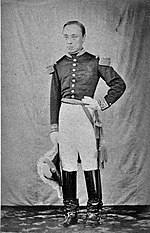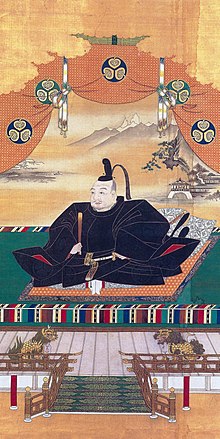Benutzer:Mkill/Tokugawa-Shogunat
| |||
| Amtssprache | Japanisch | ||
| Hauptstadt | Edo | ||
| Staatsoberhaupt | Tennō: Go-Yōzei (1586-1611) bis Kōmei (1846–1867) | ||
| Regierungschef | Tokugawa-Shōgune Tokugawa Ieyasu (1603–1616) bis Tokugawa Yoshinobu (1866–1867) | ||
| Währung | s. Shakkanhō | ||
| Zeitzone | UTC +9 | ||
Das Tokugawa-Shogunat (jap. 江戸幕府 Edo bakufu oder 徳川幕府 Tokugawa bakufu) war die feudale Militärregierung in Japan während der Edo-Zeit. Die Shōgune der Tokugawa-Familie, beginnend mit Tokugawa Ieyasu, regierten das Land von Edo, dem heutigen Tokyo aus über 265 Jahre lang, von der Schlacht von Sekigahara bis zur Meiji-Restauration.
Geschichte[Bearbeiten | Quelltext bearbeiten]
Errichtung des Shogunats durch Ieyasu[Bearbeiten | Quelltext bearbeiten]
Die Sengoku-Zeit, eine Zeit ständiger Kriege zwischen den lokalen Fürsten, den Daimyō im Japan des 16. Jahrhunderts, wurde von den Drei Reichseinigern beendet: Oda Nobunaga, Toyotomi Hideyoshi und Tokugawa Ieyasu. Ieyasu, der dritte im Bunde, war bereits unter Nobunaga und Hideyoshi ein erfolgreicher Feldherr, und sowohl deren Rivale als auch Alliierter. Nach dem Sieg über die Hōjō 1590 tauscht Hideyoshi deren Besitzungen in der Kantō-Ebene gegen Ieyasus Besitz in der Provinz Mikawa. Damit zieht Ieyasu von seinen Stammlanden Nahe Nagoya in das damals unbedeutende Fischerdorf Edo, weit entfernt von der damaligen Hauptstadt in Kyōto. Ieyasu nutzt dies jedoch, um sich hier eine neue Machtbasis aufzubauen. Mit seinem Sieg in der Schlacht von Sekigahara 1600 und der darauffolgenden Ernennung zum Shōgun 1603 wird Edo neues Zentrum von Japan.
Ieyasu errichtete daraufhin eine Dynastie, die Japan über 250 Jahre lang regierte. Die bisher regierenden Provinzfürsten wurden größtenteils auf ihren Ländereien belassen, allerdings in Kategorien eingeteilt: Shimpan-Daimyō, Verwandte und Nebenlinien des Hauses Tokugawa; Fudai-Daimyō, verläßliche Vasallen, die auf kleineren, aber strategisch wichtigen Ländereien postiert wurden; und Tozama-Daimyō, die oft große Ländereien im Norden oder Süden besaßen und ehemalige Gegner Ieyasus waren.
Politik und Gesellschaft der Edozeit[Bearbeiten | Quelltext bearbeiten]
Zu den Eckpunkten der Politik der Tokugawa gehörte eine konfuzianisch geprägte Gesellschaftsordnung, basierend auf vier Ständen (Shinōkōshō): Auf der obersten Stufe standen die Samurai, der Schwertadel, der sich im Laufe der langen Friedenszeit zu einer Beamtenkaste wandelte; die Bauern, die als Erzeuger des gesellschaftlichen Wohlstands an zweiter Stelle standen; die Handwerker; und schließlich die Händler.
Naturkatastrophen sorgten oft für Hungersnöte, und es kam zu zahlreichen Bauernaufständen. Konflikte gab es auch zwischen Händlern und Samurai: die wohlhabenden Händler der Städte konnten sich trotz ihrer nominell niedrigen gesellschaftlichen Stellung einen ausschweifenden Lebensstil leisten, den die Samurai nachzuahmen versuchten. Viele verschuldeten sich dabei.
Währenddessen kam es, geprägt von der Mito-Schule, zu einer Wiederbelebung der Verehrung des Tennō, als japanisches Staatsoberhaupt über, oder sogar anstatt der Shogune.
Außenpolitik und Außenhandel[Bearbeiten | Quelltext bearbeiten]

Mit Gründung des Shogunats wurde der Außenhandel von den Tokugawa monopolisiert. Im Jahr 1543 waren die ersten europäischen Händler nach Japan gekommen, und brachten neben Tabak vor allem das Christentum und Schusswaffen. Daher wird die Sengoku-Zeit auch als Epoche des Namban-Handels bezeichnet.
Foreign affairs and trade were monopolized by the shogunate, yielding a huge profit. Foreign trade was also permitted to the Satsuma and the Tsushima domains.
The visits of the Nanban ships from Portugal were at first the main vector of trade exchanges, followed by the addition of Dutch, English and sometimes Spanish ships.
From 1603 onward, Japan started to participate actively in foreign trade. In 1615, an embassy and trade mission under Hasekura Tsunenaga was sent across the Pacific to Nueva Espana (New Spain) on the Japanese-built galleon San Juan Bautista. Until 1635, the Shogun issued numerous permits for the so-called "red seal ships" destined for the Asian trade.
After 1635 and the introduction of Seclusion laws, only inbound ships were allowed, from China, Korea, and the Netherlands.
Außenpolitisch isolierten die Tokugawa Japan ab den 1630er Jahren völlig (Sakoku). Das Christentum wurde verboten, die bis dahin im Land befindlichen Missionare und Konvertiten verfolgt. Außenhandel fand nur noch mit Korea und China, und über eine einzelne Faktorei in Dejima mit den Holländern statt.
Bakumatsu - Endzeit des Shogunats[Bearbeiten | Quelltext bearbeiten]

Im 19. Jahrhundert begann der Druck der Amerikaner, Russen, Engländer und Franzosen auf Japan, die Isolation zu beenden, stärker zu werden. Bis 1853 konnte das Shogunat die Versuche von innen und außen, das Land zu öffnen, noch abwenden, doch Matthew Calbraith Perry gelang es schließlich durch seine Kanonenbootpolitik einen Handelsvertrag, den Vertrag von Kanagawa zu erzwingen und damit die Isolation zu beenden.
Dies rief im Land heftigen Widerstand hervor, insbesondere vom Kaiserhof in Kyōto. Die Tokugawa, die zu diesem Zeitpunkt nur schwache Shōgune aufbringen konnten Iesada und Iemochi konnten nicht verhindern, dass sich die Sonnō-jōi-Bewegung hinter Kaiser Kōmei sammelt.
Im Boshin-Krieg wurde das Shogunat schließlich geschlagen.

The Late Tokugawa Shogunate (Vorlage:Lang-ja Bakumatsu) is the period between 1853 and 1867 during which Japan ended its isolationist foreign policy called sakoku and modernized from a feudal shogunate to the Meiji government. It is at the end of the Edo period and preceded the Meiji era. The major ideological/political factions during this period were divided into the pro-imperialist Ishin Shishi (nationalist patriots) and the shogunate forces, including the elite shinsengumi (newly selected corps) swordsmen. Although these two groups were the most visible powers, many other factions attempted to use the chaos of Bakumatsu to seize personal power.[1] Furthermore there were two other main driving forces for dissent; first, growing resentment of tozama daimyo (or outside lords), and second, growing anti-western sentiment following the arrival of Perry. The first related to those lords who had fought against Tokugawa forces at Sekigahara (in 1600 AD) and had from that point on been exiled permanently from all powerful positions within the shogunate. The second was to be expressed in the phrase sonnō jōi, or "revere the Emperor, expel the barbarians". The turning point of the Bakumatsu was during the Boshin War and the Battle of Toba-Fushimi when pro-shogunate forces were defeated.[2]
Regierung[Bearbeiten | Quelltext bearbeiten]
Das Shogunat und die Han[Bearbeiten | Quelltext bearbeiten]

The bakuhan taisei (幕藩体制) was the feudal political system in the Edo period of Japan. Baku, or "tent," is an abbreviation of bakufu, meaning "military government" — that is, the shogunate. The han were the domains headed by daimyo.
Vassals held inherited lands and provided military service and homage to their lords. The Bakuhan Taisei split feudal power between the shogunate in Edo and provincial domains throughout Japan. Provinces had a degree of sovereignty and were allowed an independent administration of the Han in exchange for loyalty to the Shogun, who was responsible for foreign relations and national security. The shogun and lords were all daimyo: feudal lords with their own bureaucracies, policies, and territories. The Shogun also administered the most powerful han, the hereditary fief of the House of Tokugawa. Each level of government administered its own system of taxation.
The Shogun had the military power of Japan and was more powerful than the emperor, who was a religious and political leader.
The shogunate had the power to discard, annex and transform domains. The sankin kōtai system of alternative residence required each daimyo would reside in alternate years between the han and attendance in Edo. In their absence from Edo it was also required that they leave family as hostages until their return. The huge expenditure sankin-kotai imposed on each han helped centralize aristocratic alliances and ensured loyalty to the Shogun as each representative doubled as a potential hostage.
Tokugawa's descendants further ensured loyalty by maintaining a dogmatic insistence on loyalty to the Shogun. Fudai daimyo were hereditary vassals of Ieyasu, as well as of his descendants. Tozama, or "outsiders", became vassals of Ieyasu after the battle of Sekigahara. Shinpan, or "relatives", were collaterals of Tokugawa Hidetada. Early in the Edo period, the shogunate viewed the tozama as the least likely to be loyal; over time, strategic marriages and the entrenchment of the system made the tozama less likely to rebel. In the end, it was the great tozama of Satsuma, Chōshū and Tosa and to a lesser extent Hizen that brought down the shogunate. These four states are called the Four Western Clans or Satchotohi for short.
The number of han (roughly 250) fluctuated throughout the Edo period. They were ranked by size, which was measured as the number of koku that the domain produced each year. One koku was the amount of rice necessary to feed one adult male for one year. The minimum number for a daimyo was ten thousand koku; the largest, apart from the shogun, was a million.
Shogun and emperor[Bearbeiten | Quelltext bearbeiten]
Despite the establishment of the shogunate, the emperor in Kyoto was still the legitimate ruler of Japan. The administration (体制 taisei) of Japan was a task given by the Imperial Court in Kyoto to the Tokugawa family, which they returned to the court in the Meiji Restoration.
The shogunate appointed a liaison, the Kyoto Shoshidai (Shogun's Representative in Kyoto), to deal with the emperor, court and nobility.
Institutions of the shogunate[Bearbeiten | Quelltext bearbeiten]
Rōjū and wakadoshiyori[Bearbeiten | Quelltext bearbeiten]
The rōjū (老中) were the senior members of the shogunate. They supervised the ōmetsuke, machibugyō, ongokubugyō and other officials, oversaw relations with the Imperial Court in Kyoto, kuge (members of the nobility), daimyo, Buddhist temples and Shinto shrines, and attended to matters like divisions of fiefs. Normally, four or five men held the office, and one was on duty for a month at a time on a rotating basis. They conferred on especially important matters. In the administrative reforms of 1867, the office was eliminated in favor of a bureaucratic system with ministers for the interior, finance, foreign relations, army, and navy.
In principle, the requirements for appointment to the office of rōjū were to be a fudai (hereditary) daimyo and to have a fief assessed at 50 000 koku or more. However, there were exceptions to both criteria. Many appointees came from the offices close to the shogun, such as soba yōnin, Kyoto shoshidai, and Osaka jōdai.
Irregularly, the shoguns appointed a rōjū to the position of tairō (great elder). The office was limited to members of the Ii, Sakai, Doi, and Hotta clans, but Yanagisawa Yoshiyasu was given the status of tairō as well. Among the most famous was Ii Naosuke, who was assassinated in 1860 outside the Sakuradamon Gate of Edo Castle.
The wakadoshiyori were next in status below the rōjū. An outgrowth of the early six-man rokuninshū (1633–1649), the office took its name and final form in 1662, but with four members. Their primary responsibility was management of the affairs of the hatamoto and gokenin, the direct vassals of the shogun.
Some shoguns appointed a soba yōnin. This person acted as a liaison between the shogun and the rōjū. The soba yōnin increased in importance during the time of the fifth shogun Tokugawa Tsunayoshi, when a wakadoshiyori, Inaba Masayasu, assassinated Hotta Masatoshi, the tairō. Fearing for his personal safety, Tsunayoshi moved the rōjū to a more distant part of the castle. Some of the most famous soba yōnin were Yanagisawa Yoshiyasu and Tanuma Okitsugu.
Ōmetsuke and metsuke[Bearbeiten | Quelltext bearbeiten]
The ōmetsuke and metsuke were officials who reported to the rōjū and wakadoshiyori. The five ōmetsuke were in charge of monitoring the affairs of the daimyo, kuge and imperial court. They were in charge of discovering any threat of rebellion. Early in the Edo period, daimyo such as Yagyū Munefuyu held the office. Soon, however, it fell to hatamoto with rankings of 5000 koku or more. To give them authority in their dealings with daimyo, they were often ranked at 10 000 koku and given the title of kami (an ancient title, typically signifying the governor of a province) such as Bizen-no-kami.
As time progressed, the function of the ōmetsuke evolved into one of passing orders from the shogunate to the daimyo, and of administering to ceremonies within Edo Castle. They also took on additional responsibilities such as supervising religious affairs and controlling firearms. The metsuke, reporting to the wakadoshiyori, oversaw the affairs of the vassals of the shogun. They were the police force for the thousands of hatamoto and gokenin who were concentrated in Edo. Individual han had their own metsuke who similarly policed their samurai.
San-bugyō[Bearbeiten | Quelltext bearbeiten]
The san-bugyō ("three administrators") were the jisha, kanjō, and machi-bugyō, which oversaw temples and shrines, accounting, and the cities, respectively. The jisha bugyō had the highest status of the three. They oversaw the administration of Buddhist temples (ji) and Shinto shrines (sha), many of which held fiefs. Also, they heard lawsuits from several land holdings outside the eight Kantō provinces. The appointments normally went to daimyo; Ōoka Tadasuke was an exception, though he later became a daimyo.
The kanjō bugyō were next in status. The four holders of this office reported to the rōjū. They were responsible for the finances of the shogunate.
The machi bugyō were the chief city administrators of Edo and other cities. Their roles included mayor, chief of the police (and, later, also of the fire department), and judge in criminal and civil matters not involving samurai. Two (briefly, three) men, normally hatamoto, held the office, and alternated by month.
Three Edo machi bugyō have become famous through jidaigeki (period films): Ōoka Tadasuke and Tōyama Kinshirō as heroes, and Torii Yōzō as a villain.
The san-bugyō together sat on a council called the hyōjōsho. In this capacity, they were responsible for administering the tenryō, supervising the gundai, the daikan and the kura bugyō, as well as hearing cases involving samurai.
Tenryō, gundai and daikan[Bearbeiten | Quelltext bearbeiten]
The shogun directly held lands in various parts of Japan. These were known as bakufu chokkatsuchi; since the Meiji period, the term tenryō has become synonymous. In addition to the territory that Ieyasu held prior to the Battle of Sekigahara, this included lands he gained in that battle and lands gained as a result of the Summer and Winter Sieges of Osaka. By the end of the seventeenth century, the shogun's landholdings had reached four million koku. Such major cities as Nagasaki and Osaka, and mines, including the Sado gold mine, also fell into this category.
Rather than appointing a daimyo to head the holdings, the shogunate placed administrators in charge. The titles of these administrators included gundai, daikan, and ongoku bugyō. This last category included the Osaka, Kyoto and Sumpu machibugyō, and the Nagasaki bugyō. The appointees were hatamoto.
Gaikoku bugyō[Bearbeiten | Quelltext bearbeiten]
The gaikoku bugyō were administrators appointed between 1858 and 1868. They were charged with overseeing trade and diplomatic relations with foreign countries, and were based in the treaty ports of Nagasaki and Kanagawa (Yokohama).
List of the Tokugawa Shoguns[Bearbeiten | Quelltext bearbeiten]
- Tokugawa Ieyasu, ruled 1603–1605
- Tokugawa Hidetada, r. 1605–1623
- Tokugawa Iemitsu, r. 1623–1651
- Tokugawa Ietsuna, r. 1651–1680
- Tokugawa Tsunayoshi, r. 1680–1709
- Tokugawa Ienobu, r. 1709–1712
- Tokugawa Ietsugu, r. 1713–1716
- Tokugawa Yoshimune, r. 1716–1745
- Tokugawa Ieshige, r. 1745–1760
- Tokugawa Ieharu, r. 1760–1786
- Tokugawa Ienari, r. 1787–1837
- Tokugawa Ieyoshi, r. 1837–1853
- Tokugawa Iesada, r. 1853–1858
- Tokugawa Iemochi, r. 1858–1866
- Tokugawa Yoshinobu, r. 1867–1868
Over the course of the Edo period, influential relatives of the shogun included:
- Tokugawa Mitsukuni of the Mito domain
- Tokugawa Nariaki of the Mito domain
- Tokugawa Mochiharu of the Hitotsubashi branch
- Tokugawa Munetake of the Tayasu branch.
- Matsudaira Katamori of the Aizu branch.
- Matsudaira Sadanobu, born into the Tayasu branch, adopted into the Hisamatsu-Matsudaira of Shirakawa.
See also[Bearbeiten | Quelltext bearbeiten]
References[Bearbeiten | Quelltext bearbeiten]
- ↑ Shinsengumi, The Shogun's Last Samurai Corps, Romulus, Hillsborough, Tuttle Publishing, 2005
- ↑ Last Samurai - The Life and Battles of Saigo Takamori, Mark Ravina, John Wiley & Sons, 2004
- Japan
- http://hkuhist2.hku.hk/nakasendo/tokupols.htm
- SengokuDaimyo.com The website of Samurai Author and Historian Anthony J. Bryant
- Anthony J. Bryant is the author of Sekigahara 1600: The Final Struggle for Power, Praeger Publishers;(September, 2005)
Further reading[Bearbeiten | Quelltext bearbeiten]
- Bolitho, Harold. Treasures among men; the fudai daimyo in Tokugawa Japan. New Haven: Yale University Press, 1974.
- Totman, Conrad. The Collapse of the Tokugawa Bakufu, 1862-1868. Honolulu: University of Hawai'i Press, 1980.
- Totman, Conrad. Politics in the Tokugawa Bakufu, 1600-1843. Cambridge: Harvard University Press, 1967.
- Waswo, Ann Modern Japanese Society 1868-1994
- The Center for East Asian Cultural Studies Meiji Japan Through Contemporary Sources, Volume Two 1844-1882
